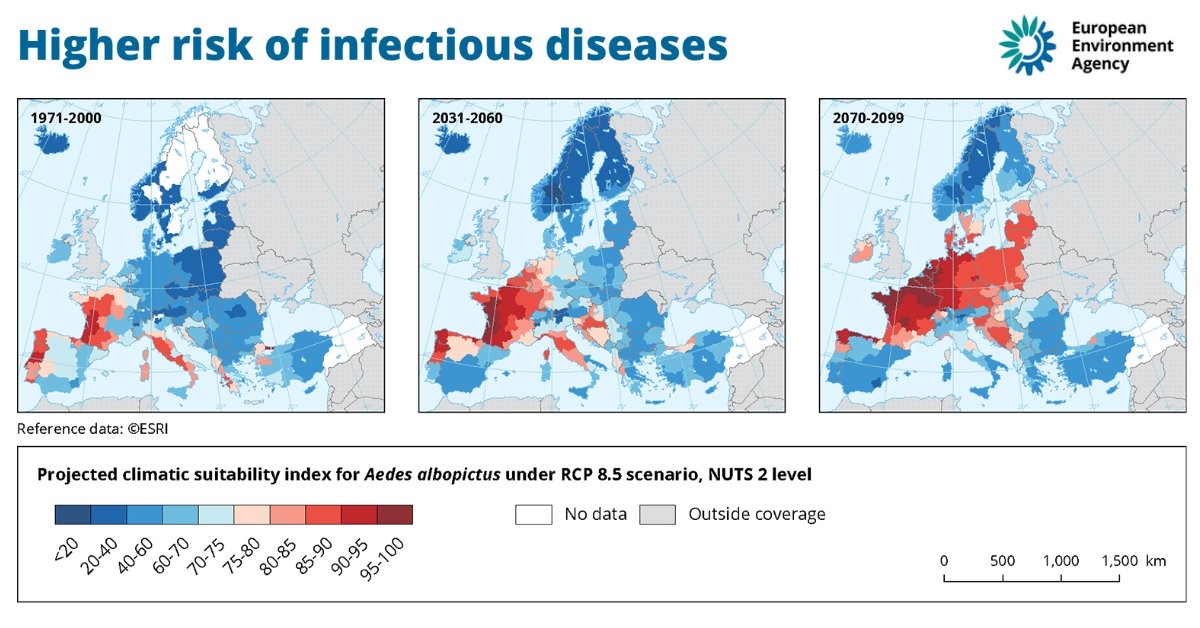Dengue, chikungunya, West Nile fever, malaria. In the cold, dark days of Europe’s winter, it may be difficult to imagine rising rates of tropical diseases. But environmental experts are warning that temperature increases would make parts of Europe ideal breeding grounds for mosquitoes while extending the area at risk of diseases spread by ticks.
In fact, it’s already happening.

For decades, dengue fever ‒ a potentially fatal disease spread by mosquitoes ‒ was almost unheard of in Europe (aside from cases of people who were infected while travelling). That has been changing in recent years, beginning with local cases reported in France and Croatia in 2010. Since then, France has seen an increase in locally-spread cases.
Outbreaks are still small, numbering in the dozens rather than the thousands. However, the European Environment Agency is warning that warmer, wetter weather could be a catalyst for much larger numbers of cases.
‘If we look at the Tiger mosquito [which can spread dengue fever], we see that the number of places in Europe suitable for this mosquito will increase strongly as temperatures rise through the century,’ Hans Bruyninckx, Executive Director of the European Environment Agency told a webinar on climate and health. ‘This is serious business for which our healthcare systems are not prepared at the moment.’

The EU has launched a new European Climate and Health Observatory and published a detailed report which projects greater susceptibility to dengue, chikungunya and Zika virus in several countries. The annual length of the season suitable for malaria transmission is also increasing, with central and eastern Europe at highest risk, it says.
‘Climate trends and projections show that climate suitability will increase for the Aedes albopictus mosquito, a vector carrying dengue, chikungunya and Zika virus disease across Europe, which, combined with increased international connectivity, increases the probability of local transmission of these diseases,’ the report warns.
Globally, the UN Intergovernmental Panel on Climate Change says an additional two billion people worldwide will live in regions at high risk of dengue fever. Not only are higher temperatures better suited to mosquitoes, floods can provide ideal breeding conditions for breeding. Mosquitoes lay eggs in water containers and can reproduce rapidly in warm, humid weather.

Distribution of ticks in Europe, showing highest rates in Central and Easter Europe. Source: European Centre for Disease Prevention and Control & European Food Safety Authority (2021)
As the climate warms, Europe will also face higher rates of tick-borne encephalitis (TBE) and Lyme disease, according to forecasts. Ticks have been spreading north and to higher altitudes, contributing to a 400% increase in TBE in European endemic areas over the past 30 years. This is attributed to mild winters and warmer, humid summers, along with better detection and diagnosis.
‘Tick-borne diseases are common across Europe but predominantly occur in central Europe, where milder winters and warmer summers are increasing the number of cases,’ the European Environment Agency says. ‘Climate change facilitates the further spread of ticks and related diseases to northern and western Europe.’
Can vaccines help?
Vaccines can protect against some, but not all, of the diseases mentioned above. The first dengue vaccine became available in 2015, with the second approved recently; Malaria vaccines have been rolled out in African countries with high rates of disease; and TBE vaccines are widely available for people in, or travelling to, high risk areas of Europe. Researchers are working on new vaccines against chikungunya, Lyme disease, malaria and dengue fever, some of which are at an advanced stage.
In the meantime, ongoing efforts to reduce carbon emissions, improved surveillance of ‘tropical’ diseases, and practical measures to reduce tick and mosquito bites, have a role to play in minimising the health impact of climate change in Europe.





Pingback
July 3rd, 2023
[…] Leer más: ¿El clima más cálido significará más enfermedades infecciosas? […]
Pingback
June 17th, 2024
[…] Read more:Will warmer climate mean more infectious diseases? […]